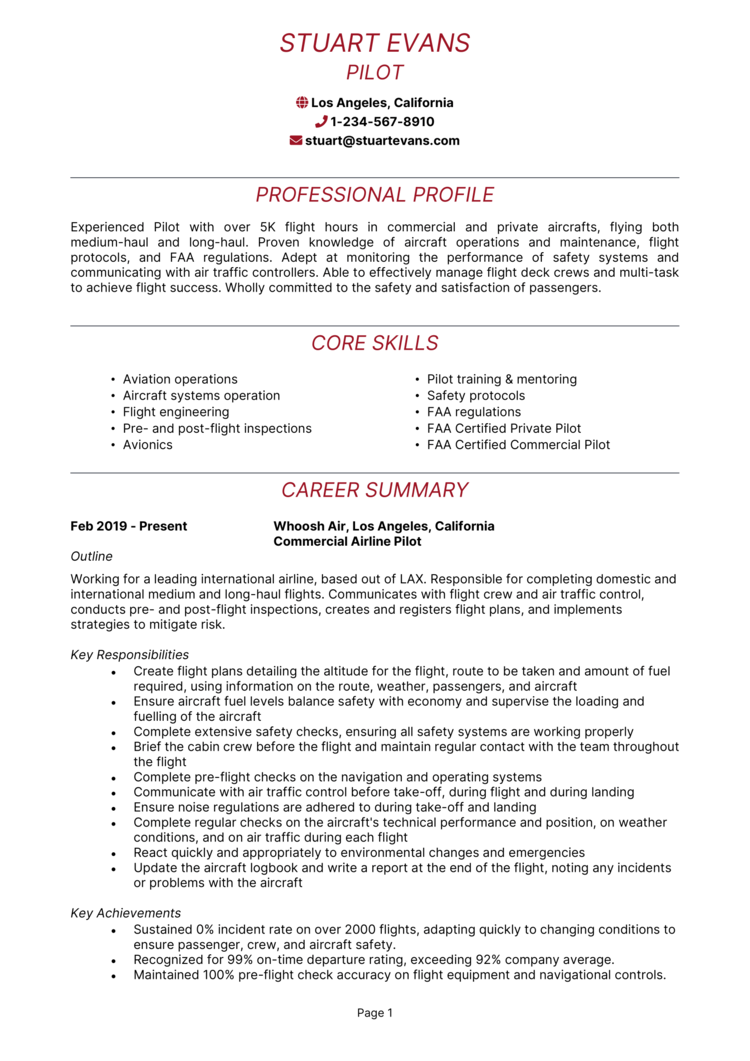A Flight Attendant's Transformation: Achieving The Dream Of Flying As A Pilot

Table of Contents
The Unique Advantages of a Flight Attendant's Background
A flight attendant's experience provides a surprisingly strong foundation for pilot training. This isn't just about familiarity with the aircraft; it's a holistic understanding of aviation that sets them apart.
Understanding Aviation from the Ground Up
Flight attendants gain invaluable insight into aviation operations from a unique perspective. This includes:
- Familiarity with aircraft types: Daily interaction with various aircraft models provides a practical understanding of their functionalities and limitations.
- Airline operations: Witnessing firsthand how airlines function—from ground handling to in-flight procedures—offers a practical knowledge base.
- Safety procedures: Extensive safety training equips flight attendants with a deep understanding of emergency protocols and risk management.
- Customer service skills: Exceptional communication and interpersonal skills, honed through passenger interaction, are crucial for pilots.
- Emergency response training: Experience in handling in-flight emergencies translates directly into crucial decision-making skills under pressure.
This practical experience translates into a head start in pilot training. Beyond the technical aspects, flight attendants develop transferable skills such as communication, teamwork, problem-solving, and the ability to remain calm under pressure—all essential qualities for a successful pilot.
Networking within the Aviation Industry
The flight attendant role offers unparalleled networking opportunities within the aviation industry. This can significantly benefit a pilot-in-training.
- Building relationships with pilots: Daily interactions create chances to build rapport and learn from experienced pilots.
- Connections with maintenance crews: Understanding the aircraft from a maintenance perspective adds another layer of valuable knowledge.
- Relationships with air traffic controllers: Observing communication procedures firsthand can be advantageous.
These connections are invaluable. Mentors can offer guidance and support, while insider knowledge about pilot training programs and career opportunities can prove invaluable.
Navigating the Transition: Overcoming the Challenges
The path from flight attendant to pilot is not without its hurdles. Significant dedication, planning, and resourcefulness are required.
Funding Flight Training
Pilot training is a substantial financial investment. Careful planning and exploration of funding options are crucial.
- Exploring financing options: Consider student loans, grants, scholarships, and even personal savings.
- Budgeting strategies: Develop a realistic budget that accounts for all expenses, including tuition, flight hours, accommodation, and living costs.
- Cost-saving tips: Look for ways to minimize expenses—consider more affordable flight schools, or explore shared accommodation options.
Many resources are available to support aspiring pilots, so thorough research is essential.
Balancing Work and Training
Juggling the demanding schedules of both jobs requires exceptional time management and prioritization skills.
- Time management techniques: Implementing effective scheduling and prioritization strategies is key.
- Prioritizing tasks: Learn to focus on the most critical tasks for both your flight attendant work and your pilot training.
- Maintaining a healthy work-life balance: Prioritizing self-care is essential to avoid burnout. This might involve reducing flight attendant hours or taking temporary leave.
Meeting the Rigorous Requirements
The path to becoming a pilot is rigorous and demanding, requiring dedication and perseverance.
- Medical certifications: Meeting stringent medical requirements is a critical first step.
- Flight school selection: Choosing the right flight school that aligns with your needs and budget is crucial.
- Meeting academic requirements: Successfully completing necessary academic coursework is essential.
- Passing flight tests: Demonstrating proficiency through rigorous flight tests is the final hurdle.
Thorough preparation is crucial for success in each of these stages.
The Rewards of Achieving the Dream: Life as a Pilot After Flight Attendant Training
The culmination of this journey—becoming a pilot after years as a flight attendant—is immensely rewarding.
A New Perspective on Flight
The shift in perspective is transformative.
- A deeper understanding of aviation: This newfound knowledge is deeply fulfilling and satisfying.
- Increased sense of responsibility: Piloting an aircraft carries immense responsibility, which brings a new level of professional fulfillment.
- Enhanced appreciation of teamwork: The experience highlights the intricate teamwork involved in every flight.
This unique journey offers a profound sense of achievement and a deeper appreciation for the complexities of aviation.
Career Advancement Opportunities
A pilot's career offers various paths for advancement.
- Opportunities for specialization: Explore areas like cargo, corporate aviation, or flight instruction.
- Promotion to senior pilot positions: Progress to captain and other senior roles is a natural progression.
- Potential for international flying: Explore the opportunities to fly internationally and experience different cultures.
The career potential for pilots is vast, with higher earning potential and a diverse range of opportunities.
Inspiring Others
This transformation is not just a personal achievement; it's a source of inspiration.
- Sharing experiences and inspiring others: Your story can motivate aspiring pilots and flight attendants alike.
- Becoming a mentor: Guide and support others pursuing similar career paths.
- Highlighting the motivational aspect of this career transformation: Your journey can inspire countless others to pursue their aviation dreams.
Soar to New Heights: Your Flight Attendant to Pilot Transformation
The flight attendant's transformation into a pilot is a challenging but profoundly rewarding journey. The unique perspective and skills gained as a flight attendant provide a strong foundation for success. While the financial investment and time commitment are significant, the rewards—a deeper understanding of aviation, a fulfilling career, and the inspiration you provide others—are immeasurable. Take the first step toward your flight attendant's transformation into a pilot today! [Link to relevant resources for flight training or pilot career information]

Featured Posts
-
 Declining Earthquake Rates On Santorini A Scientists Perspective
May 12, 2025
Declining Earthquake Rates On Santorini A Scientists Perspective
May 12, 2025 -
 Le Divorce D Eric Antoine Et La Venue Au Monde De Son Bebe Avec Sa Nouvelle Compagne
May 12, 2025
Le Divorce D Eric Antoine Et La Venue Au Monde De Son Bebe Avec Sa Nouvelle Compagne
May 12, 2025 -
 Ataque De Avestruz A Boris Johnson En Texas La Reaccion Del Exprimer Ministro
May 12, 2025
Ataque De Avestruz A Boris Johnson En Texas La Reaccion Del Exprimer Ministro
May 12, 2025 -
 Streaming Grand Slam Track Kingston Best Options For Live Coverage
May 12, 2025
Streaming Grand Slam Track Kingston Best Options For Live Coverage
May 12, 2025 -
 Onexs West Jet Investment A Successful Exit Strategy
May 12, 2025
Onexs West Jet Investment A Successful Exit Strategy
May 12, 2025
